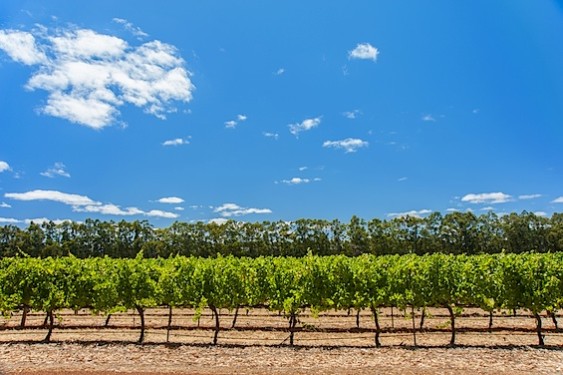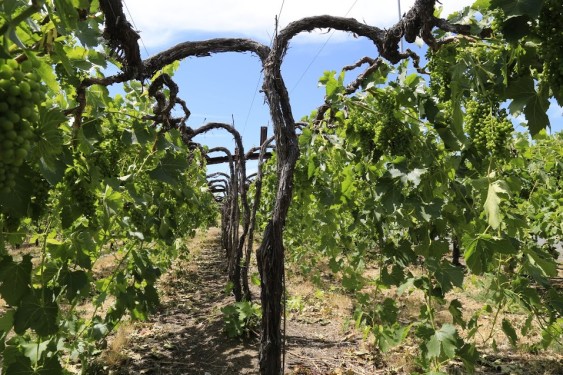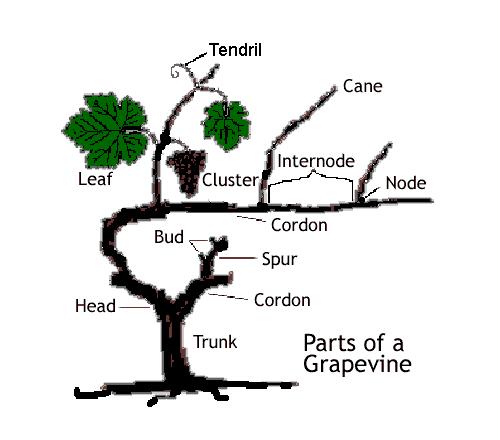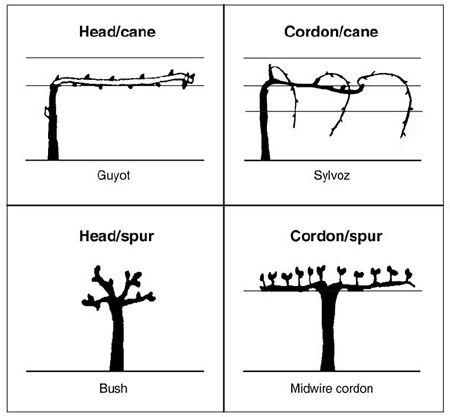I always know that I’m in wine country when I start seeing rows and rows of grapevines spreading out on either side of the road. While the plants seem to be arranged in tidy, ramrod-straight regiments, there is actually a lot more to vine layout than making sure they line up.

A lot more thought goes into those grape vines than just planting them in even spacing.
In fact, there is a whole science (or art, depending how you look at it) to planting grapevines and managing their growth. I’ll leave the planting process for a later post, but equally fascinating is the way that grapevines’ leaves, called “canopies,” are managed, or “trained.”
Why Train?
Grapevines are trained in order to promote photosynthesis and optimal grape ripening. You’ve got to have enough leaves to perform the photosynthesis necessary to ripen your grapes and protect them from too much sun, but not so many that they shade the grapes and prevent them from full developing. It’s all about finding the right balance…and yeah, it can be tricky.

These vines have been trained like “curtains” to reduce the shade and help the grapes ripen. Image source: WSU.
Not only that, but winegrowers have to take climactic influences into account as well. For instance, if you’re in a windy region, you have to make sure your grapes are protected from strong gusts (otherwise they might fall off!) and can leave thicker foliage on the vine because you don’t have to worry so much about things like rot or mildew since the wind should dry off any residual moisture.

Old vines that haven’t been trained, with free-growing cordons. Image source: WSU.
Grapevines are also climbing plants, so they shoot straight up and they can develop thick roots and trunks after many years. However, while they are young, without a trellis system that guides their growth and lends support, the vine would not be able to support the weight of its leaves and grape clusters. So winegrowers “train” them along the wires and supports of a trellis system.
The Vine
Before we talk about the training itself, it’s good to know the various parts of the grapevine itself. Below ground are the roots, and then the first part above ground is the trunk. Both are self-explanatory. Then come the cordons. These are the parts that shoot off the trunk and form woody “arms.” Vines are generally trained to have either one cordon, usually horizontal in a “T” shape, though in some parts of the world, they are trained vertically to form “V” or “Y” shapes. Those littler branches that grow off the cordons and support the leaves and grapes are called either canes or spurs. Canes are larger and usually 1-2 years old, while spurs are newer growth and smaller.

Grape vines have more parts than you think! Image source: Wine Tasting San Diego.
Training Types
While there are dozens of specific ways to train a grapevine, there are two main categories into which they all fall. The first is cane training and the second is spur training.
Cane training is when you leave the cordons intact but cut off almost all of the cane growth except for some of the younger ones that you want to bear fruit in the following season. This training method is better suited for cold climates.
Vines that are spur-trained have all but a few of the new spurs cut off. This is generally an easier method of training, but growth can be uneven.
That’s a lot of vine nomenclature, but to make things easier, here’s a diagram showing four popular training methods from Cornell’s Horticulture Department.

Common vine training systems.
As you can see, the top two cane-trained vines have their longer, older canes left intact, while the two spur-trained examples are cut back to their thick cordons with a lot more of the littler spurs left to bear leaves and fruit.
We haven’t even gotten into the various heights, shapes and spacing by which grapevines can be trained. But those are important, too, as they determine the amount of sunlight grapes and leaves get, the orientation of the vineyard, and more.
While you don’t be quizzed on the specific training system you’re seeing, next time you’re out in a vineyard, have a look at the grapevines around you and try to pick out the pattern by which the vines are trained. Are the cordons up high with canes and spurs growing horizontally or down from them? Are the cordons lower to the ground with canes stretching skyward? Are the vines even trained at all, or do the cordons merely grow off the trunk pell-mell?
Figuring out a few of those simple elements will tell you a lot more (or at least help you ask the right questions!) about the vineyard, the grapes and the wine that’s going to be produced.

